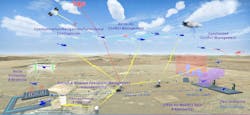Remember The Jetsons? If not, your parents or grandparents surely do.
The Jetsons was an animated series – back then, we called them "cartoons" – a futuristic TV show in the early 1960s. The title family, George and Jane Jetson and their two kids, Judy and Elroy, lived in Orbit City with their dog Astro in the 2060s. Their space-age life included a robot maid named Rosie and George commuted to his job at Spacely Space Sprockets in the family aerocar, a transparent, bubble-top flying car purchased from… wait for it… Molecular Motors.
Much of the then-incredible technology from that show is now commonplace. After all, I have a robot vacuum cleaner and participate in video chats on an almost daily basis (especially now, with a shelter-at-home order in place). And even the aerocar may be closer than we think.
The National Aeronautics and Space Administration (NASA) recently signed agreements with 17 private aviation companies under the Space Act. These companies will be participating in NASA’s first ever Urban Air Mobility (UAM) Grand Challenge (GC-1), a research and demonstration effort intended to evaluate “all elements of UAM operations under a variety of weather, traffic and contingency conditions” in actual urban environments.
Of the companies involved, only Joby Aviation was selected to actually provide a vehicle to fly in the initial GC-1 event, known as the Grand Challenge Developmental Test (GC-DT) scheduled for later this year. Five other companies — Bell, Boeing, NFT, Prodentity, and Zeva — were selected to participate in the “vehicle provider information exchange”. These companies will provide NASA with information about the aircraft that they intend to use in the GC-1 to be held in 2022. Joby, Bell and Boeing, along with automaker Hyundai and others, are all part of Uber Elevate, Uber’s “aerial ridesharing” (i.e., shared air transportation) effort.
According to NASA, the UAM program, when fully implemented, will provide safe and efficient air transportation for passengers and cargo, in densely populated urban locations. Robert Pearce, NASA’s associate administrator for aeronautics, had this to say about GC-1: “With this step, we’re continuing to put the pieces together that we hope will soon make real the long-anticipated vision of smaller piloted and unpiloted vehicles providing a variety of services around cities and in rural areas”. The GC-1 is also intended to promote public safety by partnering with the Federal Aviation Administration (FAA) so that they can develop the appropriate regulations.
It won’t be tomorrow, of course. But the day is coming when your HVAC tech will arrive at a service call in his or her aerocar. The question is, will they have a robot assistant with them?
-------------------------------------------------------------------
A regular contributor to HPAC Engineering and a member of its editorial advisory board, Larry Clark is a principal at Sustainable Performance Solutions LLC, a south Florida-based engineering firm focusing on energy and sustainability. Email him at [email protected].
About the Author
Larry Clark
A member of HPAC Engineering’s Editorial Advisory Board, Lawrence (Larry) Clark, QCxP, GGP, LEED AP+, is principal of Sustainable Performance Solutions LLC, a South Florida-based engineering firm focused on energy and sustainability consulting. He has more than two dozen published articles on HVAC- and energy-related topics to his credit and frequently lectures on green-building best practices, central-energy-plant optimization, and demand-controlled ventilation.

